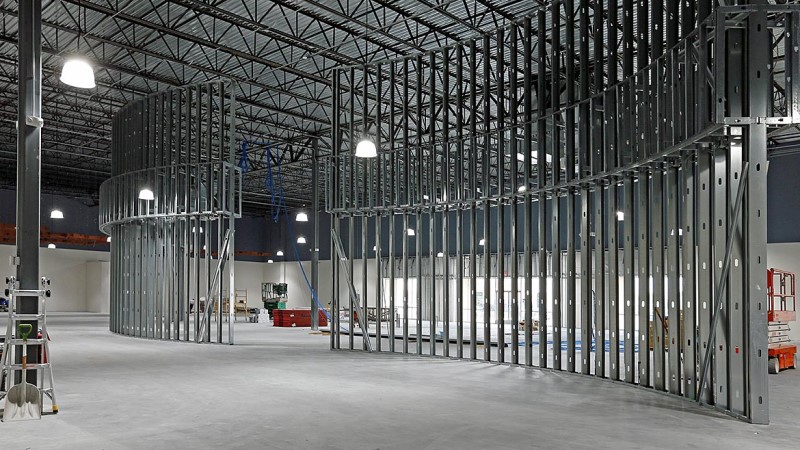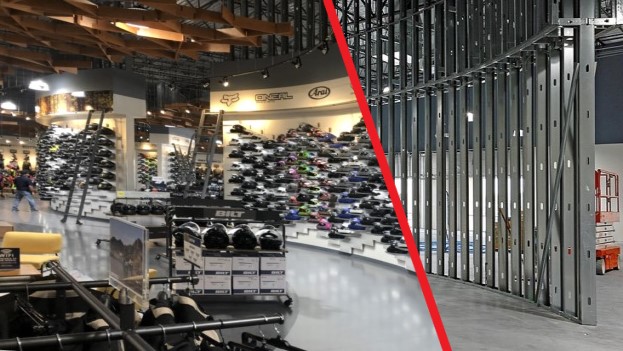The concept of incorporating curves into design is by no means groundbreaking. Throughout history, architects have leveraged the timeless elegance of curves in various elements such as soffits, walls, arches, and domes. These graceful contours have long been revered for infusing a sense of opulence and craftsmanship into architectural compositions. Curves possess the remarkable ability to soften spaces, guide the flow of movement, temper the rigidity of linear forms, and inject a delightful touch of whimsy. While curves themselves are not novel, the methods employed to construct and install them have evolved over time.
The market now offers a plethora of metal framing products and techniques that enable contractors to efficiently and securely create flawless, curvaceous structures. By exploring these options, diligent contractors can seize control over curved applications using the power of steel framing. When an architect specifies the inclusion of curves, the contractor is often granted the prerogative to choose the most suitable materials to meet the requirements.
Achieving A Smoothly Curved Surface
However, framing and sheathing pose formidable challenges when dealing with curves. Achieving a smoothly curved surface with gypsum board or plywood necessitates excessive moisture and stud-based materials do not bend easily. The art of achieving a Level 5 finish on curved gypsum boards demands immense capability and labor.
The traditional approach to creating curves involves painstakingly cutting metal tracks by hand using tin snips and manually shaping them to the desired radius. Although effective, this method is fraught with safety risks, including the potential for workers to injure themselves on the sharp edges of the cut tracks. Moreover, it results in wasted materials, difficulties in securing the track to the correct radius, and compromises the integrity of the track due to the cutting process. Additionally, this traditional method is time-consuming and demands extensive labor.
Tejas Contractors Innovative Alternative
One such example happened when the motorcycle shop, Cycle Gear, in Katy, TX was being built. Ray Johnson, the owner of Tejas Contractors Inc. in Katy, Texas, took on this extremely difficult project. The project called for radius soffits and curved walls to create a captivating display for helmets and feature walls. Although heavy-gauge slip tracks were initially specified to construct the curves, Johnson drew upon his over two decades of experience to devise an innovative alternative.
Recognizing that deflection was unnecessary for this specific application, he collaborated with the project team to review and approve a novel curving process. In Johnson’s own words, “Slip track is designed for snow and wind loads, and we see it used a lot in Dallas and northern Texas. “The way it works is the wall goes up to the roof deck, going many feet up to the bottom of the roof joists. Then, we as the framing contractor cut and notch a slip track, which has perforations in it, to create a curved wall.

A slip track doesn’t do me any good in a situation like Cycle Gear because it costs me more in labor, my guys can cut their fingers, and we don’t need a product like that because snow and wind loads are not a concern in Katy.” What Johnson and other contractors have come to realize is that if a curve is constructed correctly from the outset, recalls to redo rough, flat, or uneven spots become obsolete. Drywall contractors no longer need to engage in laborious patching and repairing, and painters can proceed with their work unhindered. Johnson opted for a departure from conventional straight metal framing tracks by embracing the realm of “curvable” metal framing tracks. The market offers a range of metal framing systems that possess the ability to gracefully curve. Crafted from 20-gauge steel, most of these systems consist of segmented tracks, rendering the entire structure flexible enough to adopt a curvilinear shape. Certain designs even employ metal bending techniques to achieve the desired curves.
These tracks are available in various widths and lengths, catering to diverse project requirements. Once the track is cut to the desired length, the process of curving begins. This typically involves outlining the intended radius on the floor and skillfully bending the track to match that curvature. To ensure the stability of the curve once the track is fastened to a ceiling, floor, or wall, it must be securely secured. It is advisable to consult the manufacturer for recommendations on effectively locking the track into the desired shape. It is worth noting that some products may not be capable of being firmly secured in the desired shape, which can lead to longer installation times or, worse, instability in maintaining the intended curve. These newer curvable framing products exhibit some variations, as not all of them possess the same characteristics. Certain manually curvable framing products prove challenging to manipulate into the desired shape, while some are limited to forming only a “C” shape. In instances where an “S” shape is required, contractors must connect “C”-shaped sections end to end to create the desired “S” curve and such transitions can present additional challenges.
Specialty contractors revel in projects that demand attention to detail. They find satisfaction in their craftsmanship, and curves add an intriguing element to their work. When presented with plans that incorporate curved walls, soffits, or arches, they envision boundless possibilities. Collaborating with architects becomes crucial to acquire all the necessary information, allowing the contractor’s team to showcase their skills and deliver something more captivating than a plain, flat surface. When researching available options and successful experiences with manufacturers, valuable insights can be gleaned from product representatives, distributors, and fellow contractors. By delving into these resources, contractors can take charge of the curves instead of letting the curves take charge of them.


